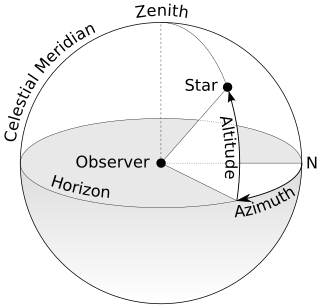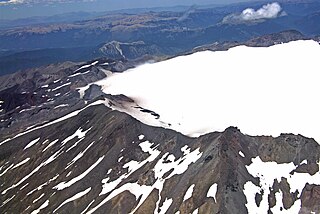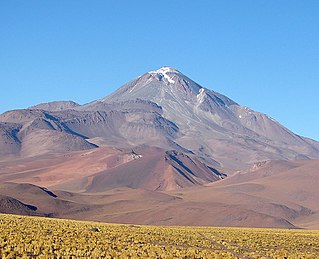| Tittivilla | |
|---|---|
Tittivilla is the first mountain below the image centre, slightly to the right. | |
| Highest point | |
| Elevation | 5,050 m (16,570 ft) [1] |
| Coordinates | 19°43′S68°11′W / 19.717°S 68.183°W [1] |
Tittivilla (also known as Titivilla or Tetivila) is an eroded volcano in the Andes of Bolivia, on the isthmus separating the Salar de Coipasa in the north from the Salar de Uyuni. The maximum slope in its summit area is 30°. [1] The stratovolcano and neighbouring Tunupa formed 3.5-2.5 mya on NE-SW and NNE-SSW structures, [2] it belongs to the Tungapujo-Guachacoyo volcanic chain. [3] The volcanoes are formed from andesite and dacite belonging to potassium-rich calc-alkaline series. [2]

A volcano is a rupture in the crust of a planetary-mass object, such as Earth, that allows hot lava, volcanic ash, and gases to escape from a magma chamber below the surface.

The Andes or Andean Mountains are the longest continental mountain range in the world, forming a continuous highland along the western edge of South America. This range is about 7,000 km (4,300 mi) long, about 200 to 700 km wide, and of an average height of about 4,000 m (13,000 ft). The Andes extend from north to south through seven South American countries: Venezuela, Colombia, Ecuador, Peru, Bolivia, Chile and Argentina.

Bolivia, officially the Plurinational State of Bolivia is a landlocked country located in western-central South America. The capital is Sucre while the seat of government and financial center is located in La Paz. The largest city and principal industrial center is Santa Cruz de la Sierra, located on the Llanos Orientales a mostly flat region in the east of Bolivia.
Tittivilla underwent an edifice collapse that triggered a 20 kilometres (12 mi) long debris avalanche. The avalanche descended an altitude of 1,350 metres (4,430 ft) with an azimuth 68° and covered a surface area of 189 square kilometres (73 sq mi). The slide left a 6 kilometres (3.7 mi) wide amphitheatre on the east-northeast side of the volcano that cut through older lava flows, [1] teh amphitheatre was originally interpreted to be an explosion crater. [3]

An azimuth is an angular measurement in a spherical coordinate system. The vector from an observer (origin) to a point of interest is projected perpendicularly onto a reference plane; the angle between the projected vector and a reference vector on the reference plane is called the azimuth.
The northern side of the avalanche has large blocks up to several kilometres of length that are hard to distinguish from eroded lavas from the neighbouring Cerro Grande. The eastern sector contains megablocks and hummocks. The southern part of the slide has a much smaller scale hummocky topography. The topography of the slide was buried by the highstands of the Altiplano lakes and contains lacustrine deposits. The 28000BP Lake Minchin and 50000BP Lake Escara paleolakes certainly submerged the slide deposits. [1]
A hummock is a small knoll or mound above ground. They are typically less than 15 meters in height and tend to appear in groups or fields. It is difficult to make generalizations about hummocks because of the diversity in their morphology and sedimentology. An extremely irregular surface may be called hummocky.

The Altiplano, Collao, Andean Plateau or Bolivian Plateau, in west-central South America, is the area where the Andes are the widest. It is the most extensive area of high plateau on Earth outside Tibet. The bulk of the Altiplano lies in Bolivia, but its northern parts lie in Peru, and its southern parts lie in Chile and Argentina.

Lake Minchin is a name of an ancient lake in the Altiplano of South America. It existed where today the Salar de Uyuni, Salar de Coipasa and Lake Poopó lie. It was formerly considered the highest lake in the Altiplano but research indicated that the highest shoreline belongs to the later Lake Tauca instead.
The volcano was active in the Pliocene-Pleistocene. [3] A lava flow within the slide scar is the only clear post-collapse volcanic activity. It originates in the northern part of the slide mouth and continues for 7 kilometres (4.3 mi) to the shores of the Salar de Coipasa. [1]
The Pliocene Epoch is the epoch in the geologic timescale that extends from 5.333 million to 2.58 million years BP. It is the second and youngest epoch of the Neogene Period in the Cenozoic Era. The Pliocene follows the Miocene Epoch and is followed by the Pleistocene Epoch. Prior to the 2009 revision of the geologic time scale, which placed the four most recent major glaciations entirely within the Pleistocene, the Pliocene also included the Gelasian stage, which lasted from 2.588 to 1.806 million years ago, and is now included in the Pleistocene.
The Pleistocene is the geological epoch which lasted from about 2,588,000 to 11,700 years ago, spanning the world's most recent period of repeated glaciations. The end of the Pleistocene corresponds with the end of the last glacial period and also with the end of the Paleolithic age used in archaeology.




















